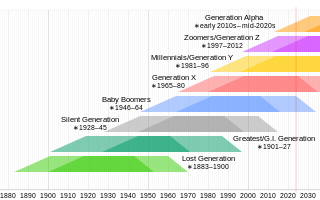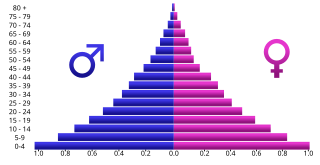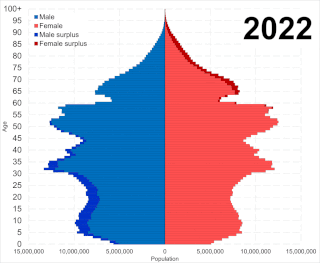
Baby boomers, often shortened to boomers, are the demographic cohort following the Silent Generation and preceding Generation X. The generation is often defined as people born from 1946 to 1964 during the mid-20th century baby boom. The dates, the demographic context, and the cultural identifiers may vary by country. Most baby boomers are the children of either the Greatest Generation or the Silent Generation, and are often parents of Gen Xers and Millennials.

Debt is an obligation that requires one party, the debtor, to pay money borrowed or otherwise withheld from another party, the creditor. Debt may be owed by sovereign state or country, local government, company, or an individual. Commercial debt is generally subject to contractual terms regarding the amount and timing of repayments of principal and interest. Loans, bonds, notes, and mortgages are all types of debt. In financial accounting, debt is a type of financial transaction, as distinct from equity.

The efficient-market hypothesis (EMH) is a hypothesis in financial economics that states that asset prices reflect all available information. A direct implication is that it is impossible to "beat the market" consistently on a risk-adjusted basis since market prices should only react to new information.
The Modigliani–Miller theorem is an influential element of economic theory; it forms the basis for modern thinking on capital structure. The basic theorem states that in the absence of taxes, bankruptcy costs, agency costs, and asymmetric information, and in an efficient market, the enterprise value of a firm is unaffected by how that firm is financed. This is not to be confused with the value of the equity of the firm. Since the value of the firm depends neither on its dividend policy nor its decision to raise capital by issuing shares or selling debt, the Modigliani–Miller theorem is often called the capital structure irrelevance principle.

The dependency ratio is an age-population ratio of those typically not in the labor force and those typically in the labor force. It is used to measure the pressure on the productive population.
In financial accounting, free cash flow (FCF) or free cash flow to firm (FCFF) is the amount by which a business's operating cash flow exceeds its working capital needs and expenditures on fixed assets. It is that portion of cash flow that can be extracted from a company and distributed to creditors and securities holders without causing issues in its operations. As such, it is an indicator of a company's financial flexibility and is of interest to holders of the company's equity, debt, preferred stock and convertible securities, as well as potential lenders and investors.

A population pyramid or "age-sex pyramid" is a graphical illustration of the distribution of a population by age groups and sex; it typically takes the shape of a pyramid when the population is growing. Males are usually shown on the left and females on the right, and they may be measured in absolute numbers or as a percentage of the total population. The pyramid can be used to visualize the age of a particular population. It is also used in ecology to determine the overall age distribution of a population; an indication of the reproductive capabilities and likelihood of the continuation of a species. Number of people per unit area of land is called population density.

Dark Age Ahead is a 2004 book by Jane Jacobs describing what she sees as the decay of five key "pillars" in "North America": community and family, higher education, science and technology, taxes and government responsiveness to citizen's needs, and self-regulation by the learned professions.

Geriatric dentistry is the delivery of dental care to older adults involving diagnosis, prevention, management and treatment of problems associated with age related diseases. The mouth is referred to as a mirror of overall health, reinforcing that oral health is an integral part of general health. In the elderly population poor oral health has been considered a risk factor for general health problems. Older adults are more susceptible to oral conditions or diseases due to an increase in chronic conditions and physical/mental disabilities. Thus, the elderly form a distinct group in terms of provision of care.

Ubungo District, officially the, Ubungo Municipal Council is one of five districts of the Dar es Salaam Region of Tanzania. The Kinondoni District and Kibaha of the Pwani Region border the district to the north; the Kisarawe District of Pwani Region borders it to the west; and the Ilala District borders the it to the south and east. The district covers an area of 269.4 km2 (104.0 sq mi). The district is comparable in size to the land area of St. Kitts and Nevis. The administrative seat is Kwembe. The district is home to the University of Dar es Salaam, The Magufuli Bus Terminal, the largest in the country, and Pande Game Reserve the largest protected land area in Dar es Salaam Region. In addition, the district is home to the largest natural gas powered power station, the Ubungo Thermal Power Station and the headquarters of the Tanzania Electric Supply Company Limited (TANESCO). The 2012 National Tanzania Census states the population of the district as 845,368.

The Demographic Window is defined to be that period of time in a nation's demographic evolution when the proportion of population of working age group is particularly prominent. This occurs when the demographic architecture of a population becomes younger and the percentage of people able to work reaches its height. Typically, the demographic window of opportunity lasts for 30–40 years depending upon the country. Because of the mechanical link between fertility levels and age structures, the timing and duration of this period is closely associated to those of fertility decline: when birth rates fall, the age pyramid first shrinks with gradually lower proportions of young population and the dependency ratio decreases as is happening in various parts of East Asia over several decades. After a few decades, low fertility however causes the population to get older and the growing proportion of elderly people inflates again the dependency ratio as is observed in present-day Europe.
Demographic dividend, as defined by the United Nations Population Fund (UNFPA), is "the economic growth potential that can result from shifts in a population’s age structure, mainly when the share of the working-age population is larger than the non-working-age share of the population ". In other words, it is "a boost in economic productivity that occurs when there are growing numbers of people in the workforce relative to the number of dependents". UNFPA stated that "a country with both increasing numbers of young people and declining fertility has the potential to reap a demographic dividend."

Gerontological nursing is the specialty of nursing pertaining to older adults. Gerontological nurses work in collaboration with older adults, their families, and communities to support healthy aging, maximum functioning, and quality of life. The term gerontological nursing, which replaced the term geriatric nursing in the 1970s, is seen as being more consistent with the specialty's broader focus on health and wellness, in addition to illness.

Japan has the highest proportion of elderly citizens of any country in the world. 2014 estimates showed that about 38% of the Japanese population was above the age of 60, and 25.9% was above the age of 65, a figure that increased to 29.1% by 2022. By 2050, an estimated one-third of the population in Japan is expected to be 65 and older.
Sustainability metrics and indices are measures of sustainability, using numbers to quantify environmental, social and economic aspects of the world. There are multiple perspectives on how to measure sustainability as there is no universal standard. Intead, different disciplines and international organizations have offered measures or indicators of how to measure the concept.
The child sex ratio in India is defined as the number of females per thousand males in the age group 0–6 years in a human population. Thus it is equal to 1000 x the reciprocal of the sex ratio in the same age group, i.e. under age seven. An imbalance in this age group will extend to older age groups in future years. Currently, the ratio of males to females is generally significantly greater than 1, i.e. there are more boys than girls.

Yung-Ping Chen was an American economist and gerontologist of Chinese origin. He pioneered the concept of home equity conversion in the United States and developed innovative approaches to the funding of Social Security benefits and long-term care. His scholarship contributed to a better understanding of the economic, political, and social implications and challenges created by the "mass aging" phenomenon—the ongoing and unprecedented shift to an increasingly elder-populated society.

China's population is aging faster than almost all other countries in modern history. In 2050, the proportion of Chinese over retirement age will become 39 percent of the total population according to projections. China is rapidly aging at an earlier stage of its development than other countries. Current demographic trends could hinder economic growth and create challenging social issues in China.

In South Korea, aging refers to an increase in the proportion of senior citizens to the total population. The term "senior citizens" include those aged 65 or older. According to Article 3 no.1 of the Framework Act on Low Birthrate of an Aging Society, the term "aging population" refers to the increasing proportion of elderly people in the entire population.














